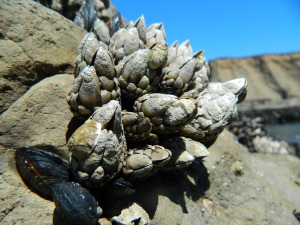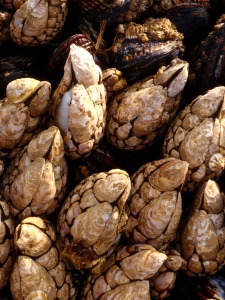Gooseneck Barnacles, pollicipes polymerus, get their name from resemblance to a goose’s neck and head. Barnacles start out as drifting aquatic organisms known as plankton. When they begin to mature, they will do a headstand and settle onto a hard surface in rocky intertidal zones. By anchoring and no longer drifting, they are now not considered plankton. Their feathery legs will stick out into the water to catch plankton and detritus, or organic matter, to feed. Their legs are surrounded by shell-like plates that help to protect these delicate creatures. They can live as long as 20 years and as they grow older, they will form more of these shells.
When walking through the rocky intertidal you will notice these barnacles clustered close to crevices. They are meant to spend their lives in the same place and are made to deal with the stressors of the rocky intertidal habitat. However disturbances from human activities, like oil spills, being extracted for consumption, or even being walked over can cause this species great harm. Gooseneck barnacles recover very slowly after being disturbed. It is best for their survival if they are seen, but not touched.
Next time you are wandering around the rocky intertidal habitat, take a look and see if you can get a glimpse of these unique looking barnacles!
References:
Edited by KC O’Shea
Photos: MSI
http://oceana.org/en/explore/marine-wildlife/gooseneck-barnacle
http://www.marinebio.net/marinescience/03ecology/tphi.htm
http://friendsoflajollashores.com/marinelife/gooseneckbarnacle/

